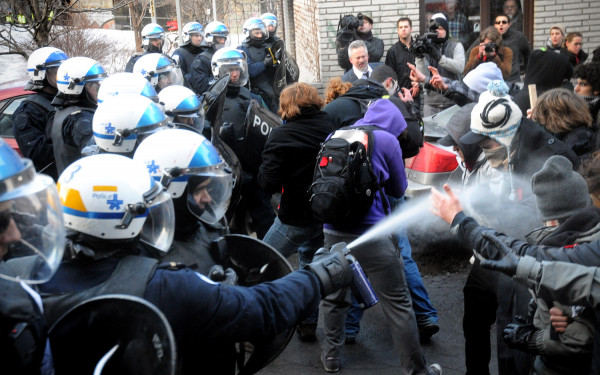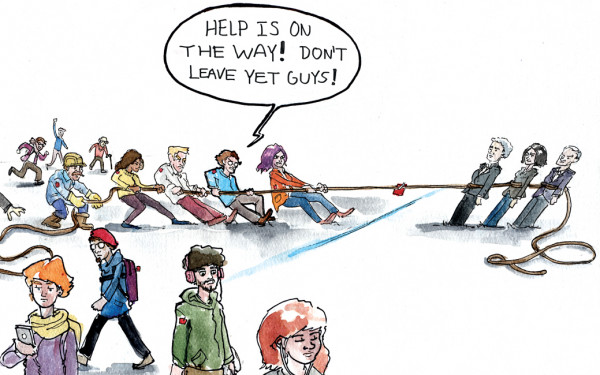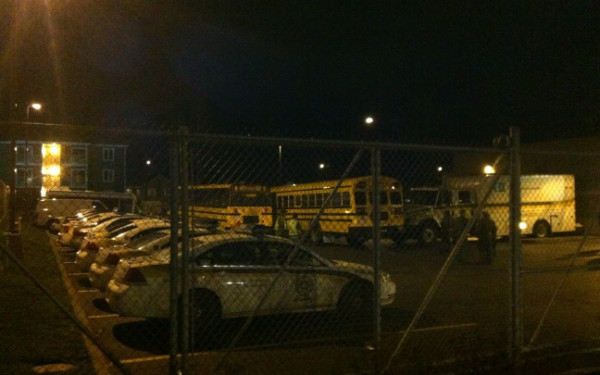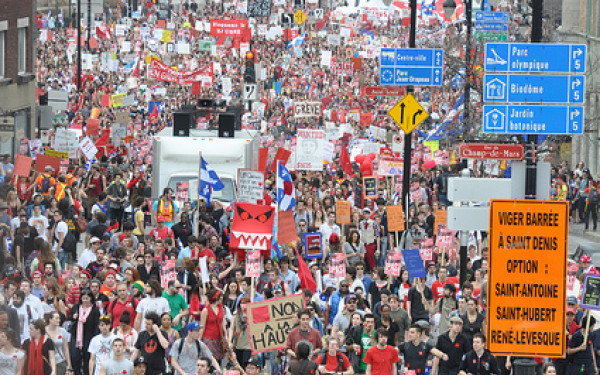Occupons Le Sud-Ouest
After The Evictions, The Activism Lives On
Last fall, a blog post by a leftist Canadian magazine Adbusters helped birth a movement.
Occupy Wall Street led the people of New York, and then the world, out into their cities in spontaneous and locally organized pop-up solidarity occupations against economic inequality.
As the days dragged into weeks and then months, the Occupiers were derided in the media, and subjected to widespread police brutality. Eventually, the protesters packed up and moved on and nothing much had changed. It seemed like a momentary blip of resistance against the one per cent.
But the movement isn’t dead.
Just shy of the one-year anniversary of Occupy Wall Street, the spirit of the movement manifested itself for two days in the southwestern part of Montreal.
Last weekend, Sir George-Étienne Cartier Square in Saint-Henri was host to Occupons le Sud-Ouest, an activist event held in the spirit of Occupy Montreal. The weekend was one in a series of “neighbourhood occupations” held since the camp at Square Victoria was taken down last November at the behest of the Service de police de la Ville de Montréal.
“We wanted a large festive day where everybody could present their projects and problems and get together,” said Paul Bode, one of the event’s organizers.
In late 2011, Bode and a group of other ex-Occupiers were looking for ways to continue the movement. They settled on a model of temporary occupations, taking over public spaces around the city for events to provide platforms for initiatives in different communities.
“What we did at la Place du Peuple was great,” said Bode, referring to the Square Victoria camp. “But it wasn’t accessible for a lot of people. People really love that we’re coming into their neighbourhoods.”
Pavement Pasta and a People’s Kitchen
Participation in the event peaked around mid-day on Saturday as workshops on community issues put on by the community group Solidarité Saint-Henri inspired spirited interventions from neighbourhood residents.
“Too much spaghetti!” cried one woman, when presented with a map of the planned reconstruction and expansion of the Turcot interchange, a complicated web of on-ramps and widened thoroughfares scheduled for completion by 2018.
The new lanes of traffic are set to demolish existing rental properties and bring pollution to the neighbourhood, according to the organization.
At the end of the presentation, maps of a citizen-proposed alternative to the project were distributed and attendees were encouraged to join the Mobilisation Turcot campaign, a group based out of the South-West that’s focused on informing the public and working with the city on the issue of the reconstruction of the Turcot interchange and the surrounding neighbourhood.
Other workshops dealt with poverty and gentrification in Saint-Henri, neo-liberalism, the Occupy movement and violence and civil disobedience.
All told, a few hundred people visited the park during the two day event, drawn by workshops, discussion groups, a free market, a “people’s kitchen,” live music, and tables where community groups presented themselves and their work.
“Occupons Montréal doesn’t come here with any kind of political goal in mind; it’s really the people in the community who bring forth the things that concern them,” said Bode.
In addition to community groups, Occupons le Sud-Ouest reached out to autonomous citizens’ assemblies (known as Assemblées populaires autonomes du Québec, or APAQs) in Point-Saint-Charles and Saint-Henri to help plan the event.
The APAQs are non-hierarchical assemblies that provide a structured platform for residents of particular neighbourhoods to discuss issues and coordinate actions. Most meet once a month, often in parks and sometimes in indoor community spaces, and operate under the principle of direct democracy.
“It’s part of our strategy of going local,” said Bode. “These APAQs and the casserole marches came up all of a sudden […] and we were like, ‘Fantastic, it’s happening on its own.’”
The event, which included programming geared at APAQ members from across the city, is part of a growing trend towards the forging of links between the neighbourhood activist groups.
APAQ Saint-Henri held its monthly assembly in the park on Saturday, and at Sunday’s popular education meeting, around 30 members from eight different APAQs discussed shared goals, like establishing an inter-APAQ information network and the ever-present problem of mobilizing more people in a post-student strike climate.
“It’s easy to go out into the street,” one participant commented. “But getting people to implicate themselves beyond that is more complicated.”
“It’s easy to go out into the street, but getting people to implicate themselves beyond that is more complicated.” – APAQ Participant
APAQs: The Casseroles Go Underground
Ask ten different activists from ten different APAQs how their groups started, and you’ll get ten different answers.
In an interview with The Link at an inter-APAQ meet-up in Parc Extension last Thursday, Michel Caisse, a member of APAQ Hochelaga-Maisonneuve, tried to explain his assembly’s origins.
“The APAQs are the baby of the casseroles,” said Caisse in reference to the popular pot and pan banging protest.
“No, we were there before the casseroles,” someone interjected. “The casseroles are the baby of the APAQs!”
A few things are certain: the APAQs date back to around the time of the casserole protests that began in May, at the high point of the mobilization against Law 12, then called Bill 78.
“We don’t have any membership, people can come as they please” said Jean-François, an activist from APAQ Rosemont who also took part in the inter-APAQ meet-up.
Action committees, small groups with names like “popular education,” “political action,” or “neighbourhood struggle” orchestrate APAQ actions.
The type of action varies greatly from neighbourhood to neighbourhood, however.
Some APAQs are focused on mobilizing residents to take part in the wider social movement: APAQ Centre-Sud, for instance, maintains links with the Coalition large de l’Association pour une solidarité syndicale étudiante—the student group responsible for much of the anti-tuition hike protests—whose offices are in the neighbourhood, and tries to mobilize Centre-Sud residents to attend national demonstrations.
Others, like APAQ Hochelaga-Maisonneuve, have been more direct, by entering local workplaces like the Montreal Port to promote the idea of a social strike and protesting the return to classes alongside CEGEP students at
Collège de Maisonneuve.
Although most people in APAQs say that the number of students coming to the assemblies has dropped since classes resumed, APAQs still attract a handful of students who feel that the promised tuition freeze is no reason to stop mobilizing.
Sarah, who decided to come to the inter-APAQ popular education meeting after participating in the Centre-Sud assembly, counts herself among the few.
“At the end of the strike, I asked myself what I had been fighting for,” she said. “Are we all going to go home, is it going to be over just because the strike is finished even though we know that it was about a lot more than that?”
She sees participation in an APAQ as a way to keep mobilizing.
But it won’t be easy.
APAQs around Montreal have suffered drops in attendance following the elections and the return to classes. Caisse admitted that at the beginning, it was normal to have 150 people at an assembly, but that now the number is closer to 40.
“But it’s okay,” said Caisse emphatically. “The people here, we’re not going to start a revolution. But there will be an event that makes people stand up, and there’s going to need to be structures and organizations that can take their anger and direct it effectively.”
In some APAQs, however, the participation problem is more serious. Julie, from APAQ Côte-des-Neiges, attends assemblies of just five or six people. She came to the popular education meeting to see what has worked for other APAQs.
“When we’re all these little groups, it’s important that we band together,” she said.

_900_448_90.jpg)
_900_600_90.jpg)
_600_832_s.png)




